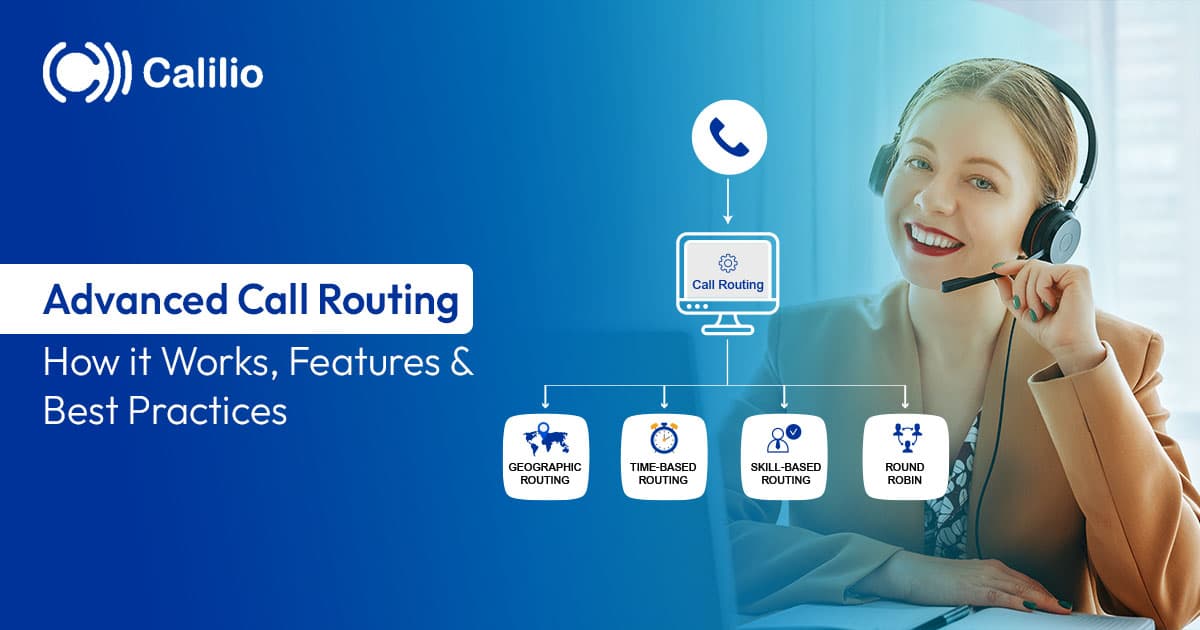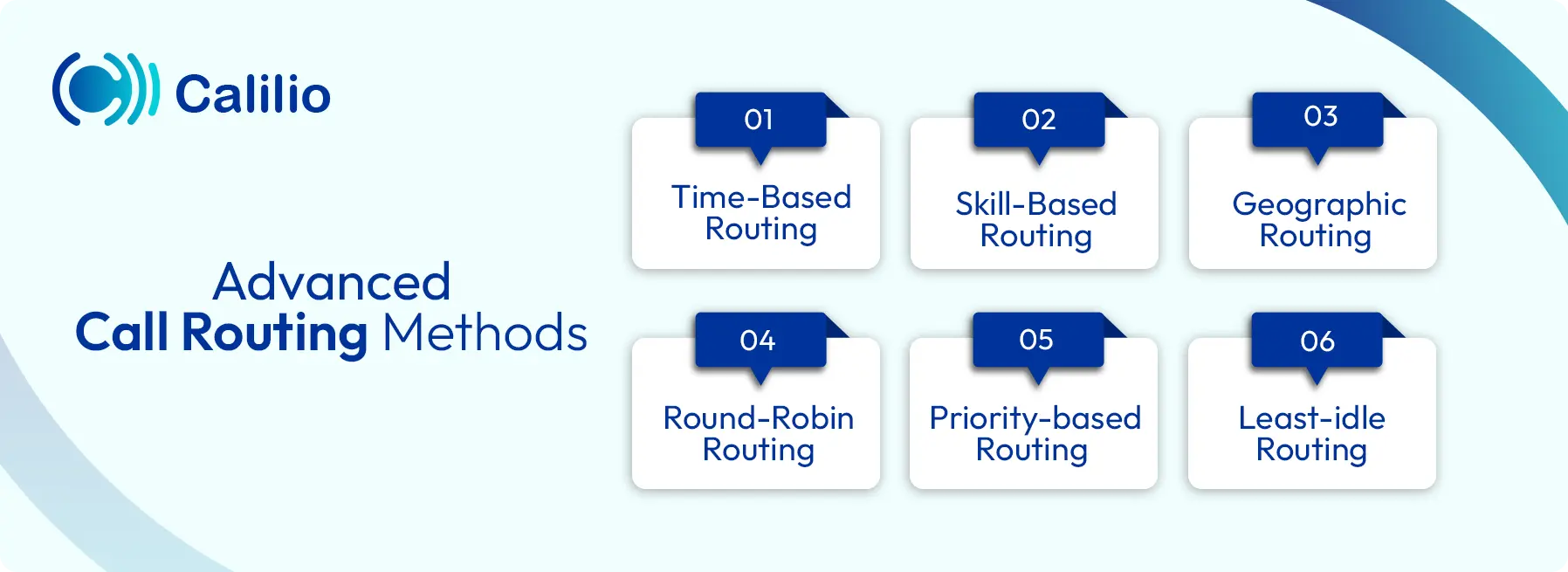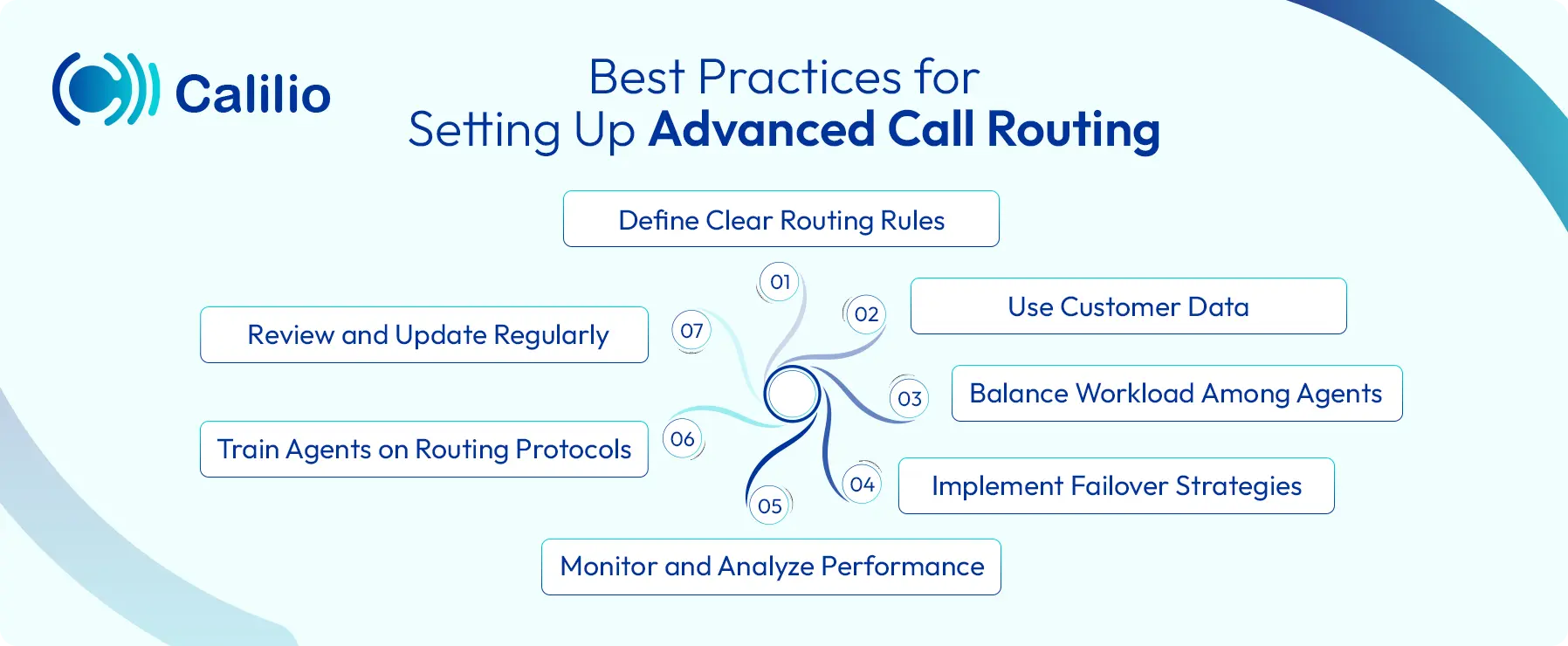What is Advanced Call Routing and How Does it Work?

Every customer expects to receive quick and accurate support when contacting a business. However, this is not possible with traditional routing methods as they lack flexibility. They often place calls in a queue or distribute them in a fixed sequence, without prioritizing customer needs. This leads to delays, inconsistent service, and lost opportunities.
Advanced call routing addresses these challenges by directing calls based on predefined rules, customer information, and real-time agent availability. It ensures every call reaches the right person at the right time to reduce wait time, improve efficiency, and manage customer interactions better.
In this guide, we will explain what advanced call routing is, how it works, the call routing methods and technologies behind it, and why it has become essential for modern businesses. We will also cover its key features and best practices for implementing it effectively.
Key Highlights:
Advanced call routing is a modern telephony feature that directs calls based on rules, customer data, and real-time agent availability.
Common call routing methods include time-based, skill-based, geographic, round-robin, least-idle, and priority-based routing.
Key technologies supporting advanced routing are Automatic Call Distributor (ACD), Interactive Voice Response (IVR), Computer Telephony Integration (CTI), CRM integration, and AI-powered systems.
Businesses need advanced call routing to achieve faster resolutions, higher first-call resolution rates, improved agent productivity, and better customer experiences.
What is Advanced Call Routing?
Advanced call routing is a modern call management feature that automatically directs incoming calls to the most suitable agent, department, or device based on predefined rules. Unlike traditional routing systems that follow a fixed order, smart call routing adapts to different factors such as agent availability, caller location, business hours, or customer history.
The purpose of advanced call routing is to improve efficiency, reduce wait times, and create a better customer experience. By matching callers with the right resource on the first attempt, businesses avoid unnecessary transfers and provide faster resolutions.
How Does Advanced Call Routing Work?
Advanced call routing uses preset rules and real-time data to decide where each call should go. When a call comes in, the system identifies the caller, checks factors like time, type of request, and agent availability, and then connects them to the right person. If no one is available, it uses backups like queuing, forwarding, or voicemail to ensure every call is attended to.
Here’s how the process usually works:
- Call Arrival: A customer dials your business number, and the system receives the call.
- Caller Identification: Information such as caller ID, account history, or chosen IVR options is detected.
- Rule Evaluation: The system applies the predefined routing rules set in your business phone system, such as routing by time of day, caller type, or department choice.
- Real-Time Agent Availability: The routing engine looks at live data such as which agents are available, their workload, and their current status to decide the best fit.
- Smart Routing: Based on those rules and real-time agent status, the call is sent to the right person, team, or even a remote device.
- Fallback Handling: If no one is available, the system can queue the call, forward it, or send it to voicemail.
Advanced Call Routing Methods
Advanced call routing uses methods such as time-based, skill-based, geographic, round-robin, least-idle, and priority-based routing to route calls efficiently.

1. Time-Based Routing
This method directs calls based on business hours or specific time zones. It’s especially useful for companies serving customers across multiple time zones.
For example, calls during office hours may be routed to your support team, while after-hours calls go straight to voicemail or another regional office.
2. Skill-Based Routing
In skill-based call routing, callers are connected to agents based on the specific skills required to handle the call. The system checks what the caller needs and routes calls to an agent who has the right qualifications or training.
For example, a customer with a technical problem is connected to a technician, while a billing query goes to the finance team.
3. Geographic Routing
This method uses the caller’s geographic details, such as area codes, to determine where the call should be directed. It ensures that customers are routed to teams familiar with their region, culture, or language, creating a more personalized service experience.
4. Round-Robin Routing
Round-robin routing distributes calls evenly among all available agents. Instead of sending most calls to the first available person, the system cycles through the team so everyone handles a fair share of calls.
For example, three sales reps, A, B, and C, are taking calls. The first call goes to A, the second to B, the third to C, and the fourth starts the cycle again with A.
5. Least-Idle Routing
Least-occupied routing sends inbound calls to the agent who has been idle the longest. If someone has been waiting without a call for several minutes while others are constantly on the phone, the next call goes to them.
6. Priority-based Routing
Priority-based routing assigns importance levels to calls and routes them accordingly. High-priority calls, such as from long-term clients, premium customers, or urgent cases, are sent to the front of the line or to specialized agents. Lower-priority calls are handled afterwards.
Essential Technologies Used in Intelligent Call Routing
Advanced call routing relies on technologies such as Automatic Call Distributor (ACD), IVR systems, Computer Telephony Integration (CTI), CRM integration, and AI with machine learning to optimize call distribution.
I. Interactive Voice Response (IVR) Systems
IVR systems let callers interact with a menu using voice or keypad input. They can route calls based on the caller’s choices (e.g., "Press 1 for Sales, 2 for Support") or even gather info before the caller reaches an agent.
II. Automatic Call Distributor (ACD)
ACD is the foundation of most call routing systems, which automatically route incoming calls based on preset rules like agent availability, skill set, or call volume. They’re built to handle high traffic and ensure callers are sent to the right person or queue.
III. Computer Telephony Integration (CTI)
CTI connects phone systems with computers. This allows agents to see caller information on their screen, pop up relevant records, and manage calls directly from their desktop.
IV. CRM Integration
Routing decisions often depend on CRM data, like customer status, history, or region. Integrating your routing system into your CRM helps prioritize high-value or returning customers and route them accordingly.
V. AI & Machine Learning
AI-powered systems can predict caller intent and route calls accordingly. They also use Natural Language Processing (NLP) to understand spoken requests and intelligently route calls without going through multiple menus.
Why Do Businesses Need Smart Call Routing?
Advanced call routing is essential for businesses to deliver efficient, data-driven customer service. It enables faster responses, better resource allocation, and stronger customer relationships through personalized call handling.
1. Shorter Wait Time
Businesses can reduce average wait times by quickly sending callers to the right department or person. Instead of transferring calls among agents, customers get help faster. That means less waiting and a smoother experience for everyone.
2. Higher First-Call Resolution Rates
When calls are routed based on skill, availability, or past interactions, there is a high chance of resolving issues right away. This increases the first call resolution rate, leading to fewer callbacks, less follow-up, and more satisfied customers.
3. Increase Agent Productivity
With intelligent call routing, agents no longer waste time handling calls outside their expertise. Instead, they focus on areas where they can deliver the most value. This boosts efficiency and prevents burnout from dealing with irrelevant queries.
4. Improve Customer Experience
When a system routes calls based on what the caller needs, customers don’t have to repeat themselves or get transferred multiple times. It shows your company respects their time and makes the experience feel more personal and less frustrating.
5. Reduce Operational Costs
By optimizing how calls are handled, businesses can serve more customers with fewer resources. It also minimizes revenue loss caused by missed or mishandled calls. Over time, this reduces operational expenses and improves return on investment.
6. More Personalized Service
Advanced routing can identify callers based on data like location, purchase history, or account type. It allows you to prioritize VIP clients or route customers to agents who know their needs. This personal touch strengthens relationships and makes customers feel valued.
Handle Every Customer Call Smarter — Unlock Advanced Call Routing Today
Best Practices for Setting Up Advanced Call Routing
To set up call routing effectively, firstly, clearly define your routing rules, and use CRM data to personalize call handling. Also, ensure to balance calls among agents, add failover strategies, monitor performance, and review the system frequently to ensure smooth and reliable call routing.

- Define Clear Routing Rules: Create routing rules based on departments, agent skills, business hours, and customer priority to ensure calls are always directed correctly.
- Use Customer Data: Integrate with CRM tools to route VIP customers or returning callers directly to agents who best understand their needs.
- Balance Workload Among Agents: Distribute calls evenly with methods like round-robin or least-idle routing to prevent agent overload and maintain efficiency.
- Implement Failover Strategies: Set up backup options such as voicemail, forwarding, or alternative teams to ensure no call goes unanswered.
- Monitor and Analyze Performance: Track key metrics like wait times and resolution speed to refine and optimize routing strategies over time.
- Train Agents on Routing Protocols: Educate agents about how calls are routed so they can handle escalations and adapt to system changes effectively.
- Review and Update Regularly: Regularly update IVR menus, routing rules, and call flows to keep the system aligned with evolving business needs.
Conclusion
Advanced call routing offers a smarter approach to handling inbound calls efficiently while supporting business growth. Using rules, data, and real-time agent availability, it ensures every call reaches the right person at the right time. It reduces wait times, increases first-call resolution, boosts agent productivity, and helps businesses offer more personalized experiences.
Calilio further enhances this experience by combining powerful routing methods with advanced telephony features. With tools like AI-driven call reports, IVR, and CRM integration, Calilio enables businesses to route calls intelligently while gaining valuable data from every interaction.
Frequently Asked Questions
Is advanced call routing suitable for small businesses?
Yes, even small businesses benefit from intelligent routing as it helps manage limited staff efficiently and ensures no customer call goes unanswered.
What industries benefit most from advanced call routing?

Still have questions?
Can’t find the answer you’re looking for? Please chat with our friendly team.
Stay in the loop
Get the latest call insights, trends, and updates delivered straight to your inbox.
By subscribing, you agree to receive updates from Calilio.
You can unsubscribe anytime.
Phone numbers
Get International Phone Numbers
Singapore
|Australia
|New Zealand

